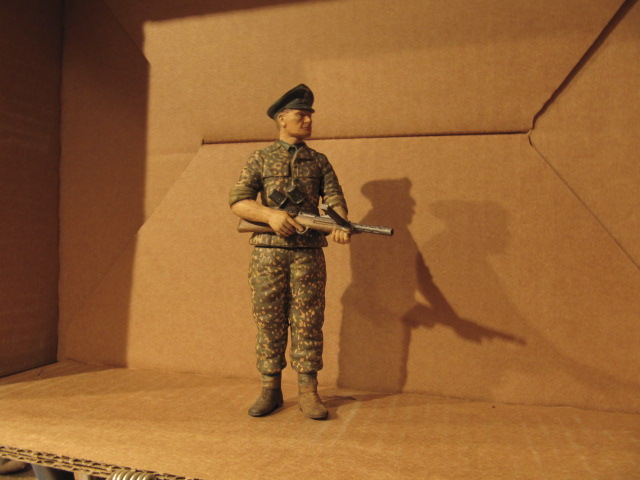Some tools, handles, mine guards and the headlight were mounted.
Then there was a micro-painting. minor paint damages and scratches were painted.
This Method is called chipping. At first a little spot of the lightened primary color (example dark yellow lightened with white) and therein a smaller spot of brown black color. This gives a 3d effect. But use this only with smallest damages of the paint in this scale (1:16)
Then the grids were dented or damaged to imitate the rough use.
Recently I have overlaid the whole model with fine scratches that I scratched very careful with a knife.
Ensure always scratch the top coat only - never possible to plastic.













Then I have built from balsa wood, wire and sheet metal Ätzteilrahmens a wooden block, because the plastic part in the kit did not like.


Then a large building phase had been completed.
The decals were fixed.
At first glossy clearcoat, then fixing of the decals. Treating of the decals with softener to adapt the decals to the rough ground.
After a short time the decals were spotted with a soft brush into the surface structure.
After drying, the decals were painted with gloss clear lacquer.
On the following day, a washing was done with thinned oil paint burnt umber.
For this, the wheels were removed and treated separately.
After Washing the hull behind the wheels had been heavily treated with pigments.
This was done as follows:
First, the area was smeared with Pigment fixer.
Then pigments were dabbed with a hard brush.
The process was repeated several times to get a heavy pollution.
Thereafter the wheels were locked.
The hubs and wheels got a washing with thinned oil paint burnt umber.
In the wet oil paint pigments were spotted.
Then came a drybrushing with white oil paint. This very very discretely!!!!!
The exhaust pipes were painted with oil paint English Red light and spotted with rust-colored pigments (or chalk in orange color)
The exhaust ports were treated with carbon black pigments.
Then the whole Kit was treated with pigments Europe Dust from Mig.
These are photos on the terrace. The lighting conditions were not optimal, because of the color of the awning.









































































































